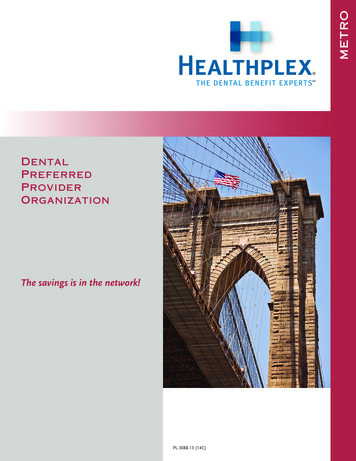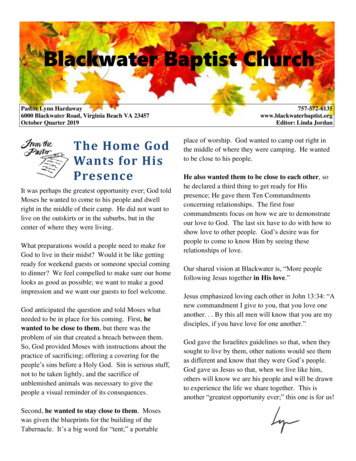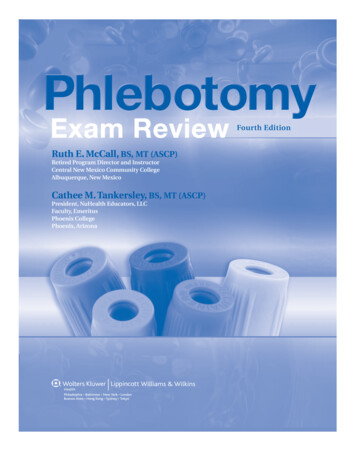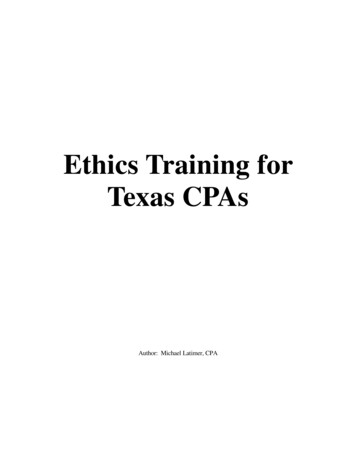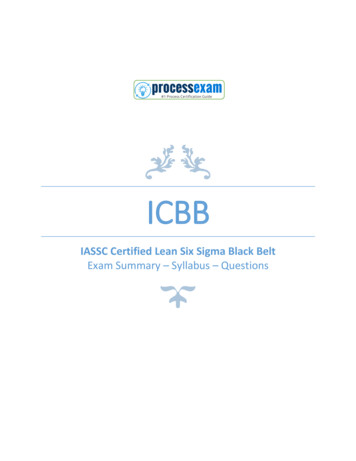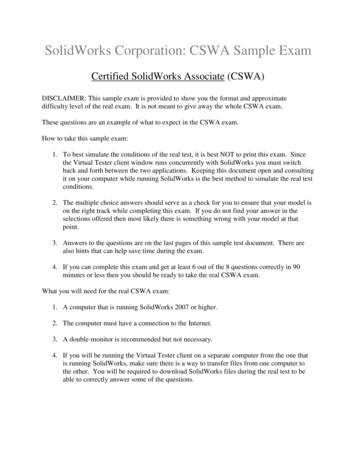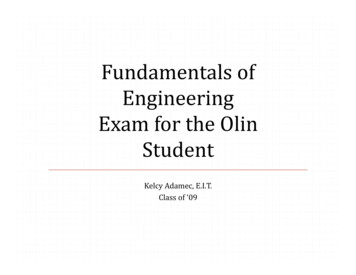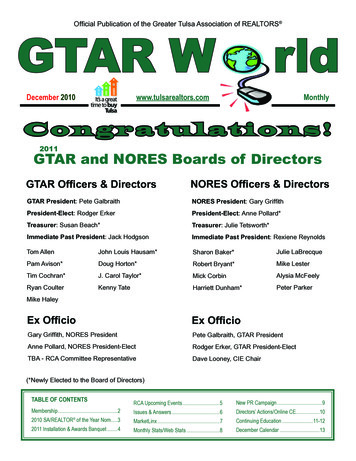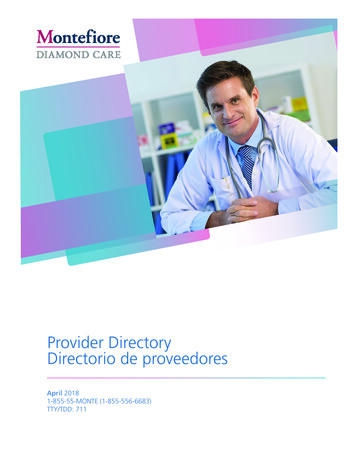
Transcription
LWBK751-C01 p01-30.qxd 14/10/2010 10:48 AM Page 1 AptaraChapter1Exam and BasicHand Instruments
BasicLWBK751-C01 p01-30.qxd 14/10/2010 10:48 AM Page 2 Aptara12INTRODUCTION TO DENTAL HAND INSTRUMENTSDental hand instruments are made of metal alloy or plastic resin. They are named according to their useor shape or named for the designer of the instrument.Hand instruments may be single- or double-ended. Advantages of double-ended: two sizes of the samedesign in one instrument, two different working ends in one instrument, or two directions of use in oneinstrument (right/left).There are three parts of a hand instrument:1. Working end. The design determines the function and may be a beveled cutting edge (chisel), a point(explorer), a nib (amalgam condenser), a blade (composite instrument) or beaks (pliers).2. Shank. Portion of the instrument that connects the handle and the working end. The shank may bestraight or angled to provide better access to different areas of the mouth.3. Handle or shaft. Rounded or hexagonal in different diameters and materials for better fit and grip.
LWBK751-C01 p01-30.qxd 14/10/2010 10:48 AM Page 3 Aptara123Basic31
BasicLWBK751-C01 p01-30.qxd 14/10/2010 10:48 AM Page 4 Aptara14MIRROR, MOUTHFUNCTION:To view tissues of the oral cavity and reflect light for better visibilityFEATURES:Front surface or plane reflective surface. Front surface mirrors reflect from thefront of the glass providing a distortion-free reflection.Mirror sizes #2–#5 (3/4 –15/16 )Magnifying and double-sided also availableReusable handles in cone socket or simple stem designTRAY SET-UP:CLINICAL APPLICATION:Exam and Basic Set-up, component of most procedural tray set-upsAlso used to retract and protect tongue and cheek
LWBK751-C01 p01-30.qxd 14/10/2010 10:48 AM Page 5 AptaraImage/photo courtesy of Miltex, www.miltex.comBasic51
BasicLWBK751-C01 p01-30.qxd 14/10/2010 10:48 AM Page 6 Aptara16EXPLORERFUNCTION:To examine tooth surfaces for caries, calculus, or defects using sense of touch (tactile)FEATURES:Thin, sharp working end comes in different designsCommon styles are the #1, 2 (pigtail), 11/12, 17, and 23 (Shepard’s hook)May be single- or double-ended (different design on each side)TRAY SET-UP:CLINICAL APPLICATION:Exam and Basic Set-up, componentof most procedural tray set-upsAlso used to:Check fit of margins of restorationsEvaluate root surfaces andfurcation area in periodontalexam (11/12)Image modified from University of Kentucky(296m-15, 2-109m)Remove excess material from restoration or preparationRemove excess cement
LWBK751-C01 p01-30.qxd 14/10/2010 10:48 AM Page 7 AptaraA#1B#2C#11/12D#17E#23Images courtesy of Hu-Friedy, www.hu-friedy.comBasic71
BasicLWBK751-C01 p01-30.qxd 14/10/2010 10:48 AM Page 8 Aptara18COTTON PLIERSFUNCTION:To place and remove small objects from the oral cavity (i.e., cotton pellets, rootcanal instruments, wedges)FEATURES:Serrated or nonserrated beaks, locking or nonlocking handlesAlso known as College pliers or dressing pliersTRAY SET-UP:CLINICAL APPLICATION:Exam and Basic Set-up, component of most procedural tray set-upsAlso used to retrieve materials from drawers and containers to avoidcross-contamination
LWBK751-C01 p01-30.qxd 14/10/2010 10:48 AM Page 9 AptaraABImages courtesy of Hu-Friedy, www.hu-friedy.comBasic91
BasicLWBK751-C01 p01-30.qxd 14/10/2010 10:48 AM Page 10 Aptara110PERIODONTAL PROBEFUNCTION:To measure depth ofgingival sulcusFEATURES:Blunt or rounded tipFlat or cylindrical working endLine or colored millimeter markings in variety ofincrementsMetal or plastic in whiteor yellow with coloredmarkingsTRAY SET-UP:Image modified from University of Kentucky (295m-07, 7-107m)Periodontal examMay be part of Basic Set-up in some officesCLINICAL APPLICATION:Also used to measure gingival recession
LWBK751-C01 p01-30.qxd 14/10/2010 10:48 AM Page 11 AptaraImages courtesy of Hu-Friedy, www.hu-friedy.comBasic111
BasicLWBK751-C01 p01-30.qxd 14/10/2010 10:48 AM Page 12 Aptara112SALIVA EJECTOR TIPFUNCTION:To remove saliva and maintain dry field using low-volume evacuationFEATURES:Disposable plasticSome designed with attached tongue deflectorTRAY SET-UP:Exam and Basic Set-up, component of most procedural tray set-ups. Used primarilywhen operator is working alone (sealants, coronal polishing, fluoride treatments,taking impressions, cementing crowns)
LWBK751-C01 p01-30.qxd 14/10/2010 10:48 AM Page 13 AptaraBasic131
BasicLWBK751-C01 p01-30.qxd 14/10/2010 10:48 AM Page 14 Aptara114ORAL EVACUATOR TIPFUNCTION:To maintain a dry working field by removing saliva, blood, and debris with highvolume evacuationFEATURES:Disposable plastic, sterilizable metal or plasticStraight or angled with beveled endsSurgical Aspirator (see Chapter 11 ORAL AND MAXILLOFACIAL SURGERYINSTRUMENTS)Also known as Aspirator, High Volume Evacuator, Suction, or Vacuum tipTRAY SET-UP:CLINICAL APPLICATION:Exam and Basic Set-up, component of most procedural tray set-upsEffective use of oral evacuator reduces microbial aerosols. Also assists in retractingand protecting tongue and cheek. On/off control is located on the suction tubing.
LWBK751-C01 p01-30.qxd 14/10/2010 10:48 AM Page 15 AptaraImage courtesy of Miltex, www.miltex.comBasic151
BasicLWBK751-C01 p01-30.qxd 14/10/2010 10:48 AM Page 16 Aptara116ISOLITE, i2 PER MANUFACTURER DRYFIELDILLUMINATORFUNCTION:To provide internal illumination, aspiration, throat protection, and tongue andcheek retraction all in one deviceFEATURES:Available in five sizes: pediatric, adult small, adult medium, adult medium deepvestibule, and adult largeDisposable mouthpiece; autoclavable control
LWBK751-C01 p01-30.qxd 14/10/2010 10:48 AM Page 17 AptaraImage courtesy of Isolite Systems, www.isolitesystems.comBasic171
BasicLWBK751-C01 p01-30.qxd 14/10/2010 10:48 AM Page 18 Aptara118ANESTHETIC SYRINGEFUNCTION:To deliver local anesthesia to intraoral siteFEATURES:Aspirating and Non-aspiratingTRAY SET-UP:CLINICAL APPLICATION:Restorative, Fixed Prosthodontic, Endodontic, Periodontic, Oral and MaxillofacialSurgery Treatment ProceduresAn aspirating syringe has a harpoon on the end of the piston, the nonaspiratingsyringe does not. With pressure, the harpoon imbeds in the rubber stopper of theanesthetic cartridge. As the dentist begins the injection, he/she draws back on thethumb ring, pulling the harpoon and the rubber stopper back and creating avacuum. This will draw in (aspirate) fluid from the farthest end of the needle. Ifblood comes back into the cartridge, the dentist will reposition the needle toprevent injecting anesthetic agent into a blood vessel.
LWBK751-C01 p01-30.qxd 14/10/2010 10:48 AM Page 19 AptaraThumb ringBarrelHarpoonPistonImage courtesy of Miltex, www.miltex.comBasic191
BasicLWBK751-C01 p01-30.qxd 14/10/2010 10:48 AM Page 20 Aptara120INTRALIGAMENT SYRINGEFUNCTION:Alternative method of delivering local anesthesia; generally to supplement a nerveblock. Injection is made in the periodontal ligament space.FEATURES:Delivers calibrated amount of anesthetic with each click of the leverCLINICAL APPLICATION:Uses 30-gauge short needles and standard 1.8-ml anesthetic cartridges
LWBK751-C01 p01-30.qxd 14/10/2010 10:48 AM Page 21 AptaraImage courtesy of Miltex, www.miltex.comBasic211
BasicLWBK751-C01 p01-30.qxd 14/10/2010 10:48 AM Page 22 Aptara122LOCAL ANESTHESIA ACCESSORIES1. Anesthetic needles:Two lengths—1 (short) and 1 5/8 (long)Three gauges (diameter)—25 gauge, 27 gauge, and 30 gaugeSome manufacturers identify gauge by color-coding capsAvailable with plastic or metal hubs2. Anesthetic cartridges:Glass vial containing anesthetic solution such as lidocaine (Xylocaine), mepivacaine (Carbocaine),prilocaine (Citanest), and bupivacaine (Marcaine).Aluminum cap with rubber diaphragm that needle penetrates at one end of cartridge.Rubber stopper at the other end.Cartridges are sterile and sealed in “blister packs.”Color coded and labeled with type of anesthetic solution and amount of vasoconstrictor.3. Recapper: Needles may be used more than one time during a procedure and must be recapped to avoidaccidental exposure. For safety, this must be done by using a recapper or the one-handed scoop technique.4. Sharps container: Needles and other disposable sharps must be disposed of in a labeled, puncture-proofcontainer.
LWBK751-C01 p01-30.qxd 14/10/2010 10:48 AM Page 23 AptaraRubber diaphragm12RubberstopperAluminum capOne-handed scoop technique34(4) Image courtesy of Crosstex, www.crosstex.comReprinted with permission from Carol R. Taylor,Carol Lillis, RN, et al. Fundamentals of Nursing:The Art and Science of Nursing Care. 6th Ed.Philadelphia: Lippincott Williams & Wilkins, 2008.Basic231
BasicLWBK751-C01 p01-30.qxd 14/10/2010 10:48 AM Page 24 Aptara124TRAY SET-UPS Assembling all instruments and materials needed for a procedure Instruments are arranged on the tray from left to right in their order of useInstruments for a given procedure are sterilized together in a bag or a wrap. Instruments remain in thesterile wrap until the time of use.
LWBK751-C01 p01-30.qxd 14/10/2010 10:48 AM Page 25 AptaraBasic251
BasicLWBK751-C01 p01-30.qxd 14/10/2010 10:48 AM Page 26 Aptara126ORAL EXAM AND BASIC SET-UP1. Mouth mirror2. Explorer3. Periodontal probe4. Cotton pliers5. Air/water syringe tip6. Oral evacuator tip7. Saliva ejector tip8. 2 2 gauze
LWBK751-C01 p01-30.qxd 14/10/2010 10:48 AM Page 27 Aptara83214567Basic271
BasicLWBK751-C01 p01-30.qxd 14/10/2010 10:48 AM Page 28 Aptara128LOCAL ANESTHESIA SET-UP1. Topical anesthetic2. Needle recapper3. 2 2 gauze4. Cotton applicator5. Anesthetic syringe6. Anesthetic needle7. Anesthetic cartridge8. Air/water syringe tip9. Oral evacuator tip
LWBK751-C01 p01-30.qxd 14/10/2010 10:48 AM Page 29 Aptara123674589Basic291
LWBK751-C01 p01-30.qxd 14/10/2010 10:48 AM Page 30 AptaraEnd Chapter 1
INTRODUCTION TO DENTAL HAND INSTRUMENTS LWBK751-C01_p01-30.qxd 14/10/2010 10:48 AM Page 2 Aptara. 3 Basic 1 1 2 3 LWBK751-C01_p01-30.qxd 14/10/2010 10:48 AM Page 3 Aptara. 4 Basic 1 MIRROR, MOUTH FUNCTION: To view tissues of the oral cavity and reflect light for better visibilityFile Size: 1MBPage Count: 30

